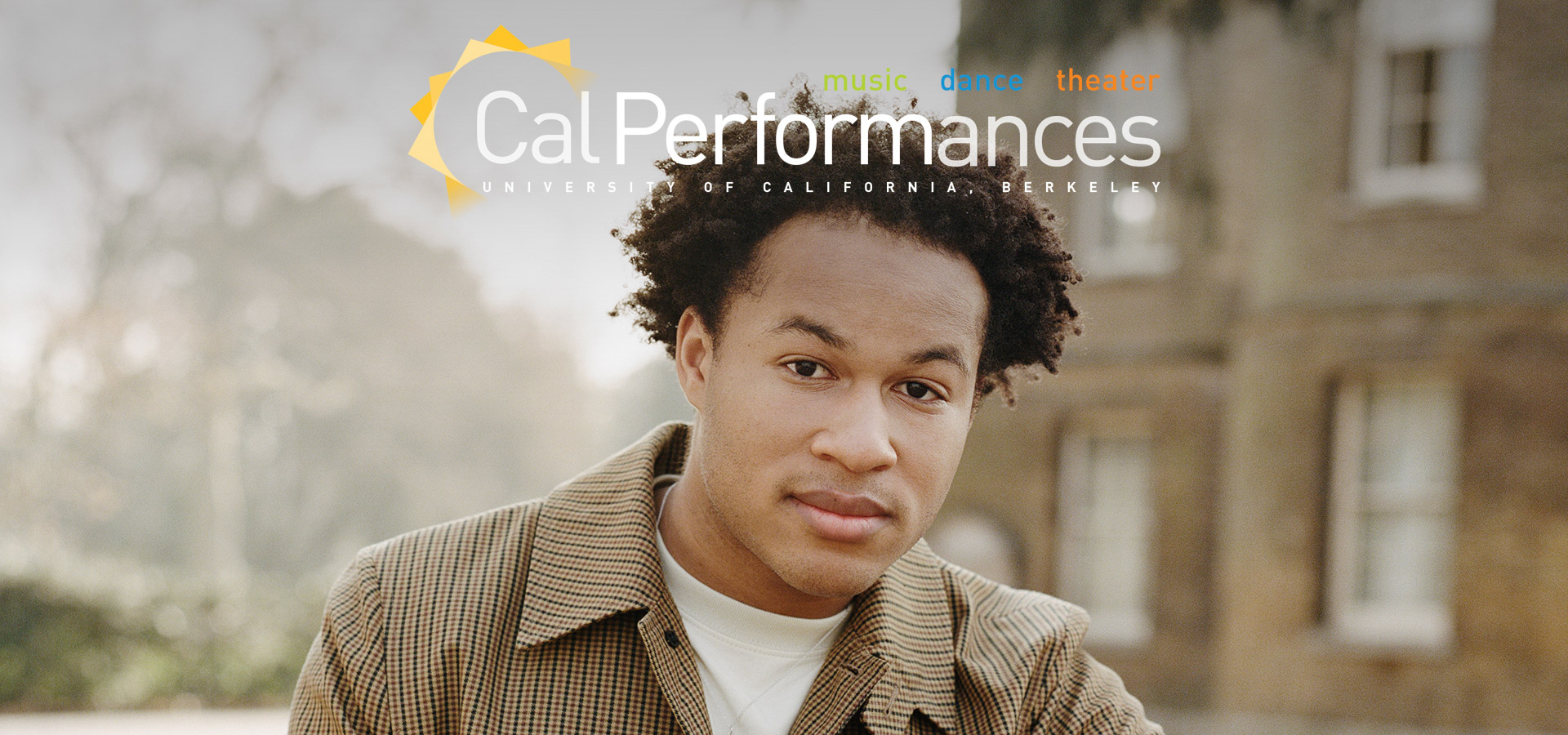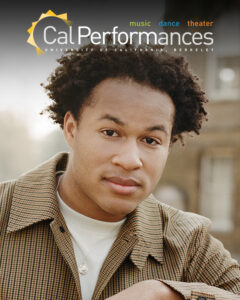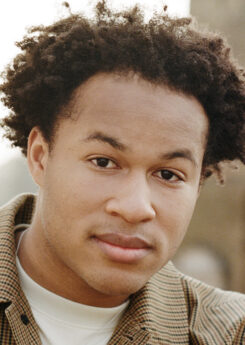Sheku Kanneh-Mason, cello
Wednesday, November 1, 2023, 7:30pm
Zellerbach Hall
This performance is made possible, in part, by Lance and Dalia Nagel.
From the Executive and Artistic Director
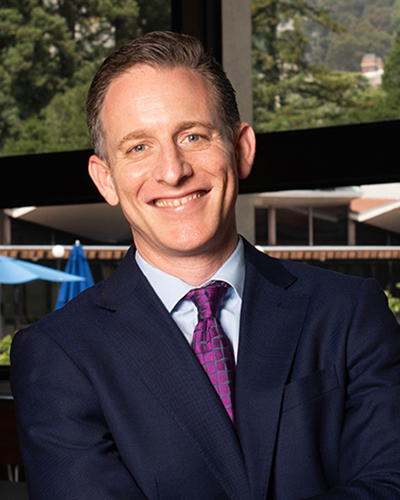
November is always a busy month at Cal Performances, and once again this season, I can’t think of a time period that so clearly displays the impressive depth and breadth of our programming. In the coming weeks alone, we’ll run the gamut of live performance, including classical-music recitals with star instrumentalists cellist Sheku Kanneh-Mason (Nov 1) and harpsichordist Jean Rondeau (Nov 5); the brilliant ensemble playing of early-music champions Le Consort (Nov 8) and the Takács Quartet (Nov 12); a return visit by the great San Francisco Symphony, performing under Music Director Esa-Pekka Salonen in a concert featuring the world premiere of a new work by Jens Ibsen and a solo turn by the orchestra’s principal clarinetist Carey Bell (Nov 10); a brilliant new program by the always popular Silkroad Ensemble under artistic director Rhiannon Giddens (Nov 17); our annual visit by The English Concert in an all-star concert performance of Handel’s Rodelina (Nov 19); cutting-edge jazz from the legendary trio of pianist Brad Mehldau (Nov 11); and highly anticipated appearances by theater/cabaret sensations John Cameron Mitchell and Amber Martin (Nov 4) and Broadway superstar Kristin Chenoweth (Nov 15).
And that’s only the start! As we continue through the season, you’ll find more than 80 carefully curated events designed to appeal to the eclectic interests and adventurous sensibilities of Bay Area audiences. In total, this year’s schedule features nearly 30 companies, ensembles, and solo artists new to our program, offering a wide range of opportunities to discover unfamiliar performers and artworks. There’s plenty to enjoy, including six world premieres, six Cal Performances co-commissions, nearly one dozen local and regional premieres, and the West Coast premieres of Taylor Mac & Matt Ray’s Bark of Millions and Nathalie Joachim’s Ki moun ou ye (Who are you?).
Cal Performances continues to invest in ongoing relationships with established and acclaimed artistic partners, with upcoming presentations including a landmark collaboration between Germany’s Pina Bausch Foundation, Senegal’s École des Sables, and the UK’s Sadler’s Wells theater in the first-ever Bay Area performances of Bausch’s pioneering The Rite of Spring (1975), as well as the renewal of a multi-season residency by The Joffrey Ballet, which this year will present its first full-length narrative ballet, Anna Karenina, at Zellerbach Hall. And I’m especially pleased that in March 2024, the renowned pianist Mitsuko Uchida will join us as Artist in Residence for two special concerts as well as additional opportunities for the campus and wider Bay Area community to engage with her singular artistry.
A focus of the season will be our multi-dimensional Illuminations programming, which once again will connect the work of world-class artists to the intellectual life and scholarship at UC Berkeley via performances and public programs investigating a pressing theme—this season, “Individual & Community.” Concepts of “individual” and “community” have been at the forefront of public discourse in recent years, with some models increasing polarization and radicalization within our society. Questions have emerged as to how we can best nurture a sense of community and how the groups we associate with impact our own sense of self. Given our fast-evolving social landscape, how can we retain and celebrate the traits that make each of us unique, while still thriving in a world that demands cooperation and collaboration? With the performing arts serving as our guide and compass, our 2023–24 “Individual & Community” programming will explore the tensions that come into play when balancing the interests of the individual with those of the group.
Please make sure to check out our website for complete information. We’re thrilled to share all the details with you, and to welcome you once again to Cal Performances!
Jeremy Geffen
Executive and Artistic Director, Cal Performances
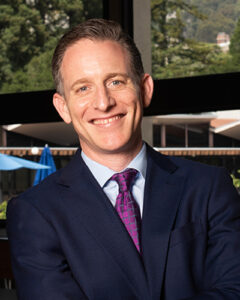 November is always a busy month at Cal Performances, and once again this season, I can’t think of a time period that so clearly displays the impressive depth and breadth of our programming. In the coming weeks alone, we’ll run the gamut of live performance, including classical-music recitals with star instrumentalists cellist Sheku Kanneh-Mason (Nov 1) and harpsichordist Jean Rondeau (Nov 5); the brilliant ensemble playing of early-music champions Le Consort (Nov 8) and the Takács Quartet (Nov 12); a return visit by the great San Francisco Symphony, performing under Music Director Esa-Pekka Salonen in a concert featuring the world premiere of a new work by Jens Ibsen and a solo turn by the orchestra’s principal clarinetist Carey Bell (Nov 10); a brilliant new program by the always popular Silkroad Ensemble under artistic director Rhiannon Giddens (Nov 17); our annual visit by The English Concert in an all-star concert performance of Handel’s Rodelina (Nov 19); cutting-edge jazz from the legendary trio of pianist Brad Mehldau (Nov 11); and highly anticipated appearances by theater/cabaret sensations John Cameron Mitchell and Amber Martin (Nov 4) and Broadway superstar Kristin Chenoweth (Nov 15).
November is always a busy month at Cal Performances, and once again this season, I can’t think of a time period that so clearly displays the impressive depth and breadth of our programming. In the coming weeks alone, we’ll run the gamut of live performance, including classical-music recitals with star instrumentalists cellist Sheku Kanneh-Mason (Nov 1) and harpsichordist Jean Rondeau (Nov 5); the brilliant ensemble playing of early-music champions Le Consort (Nov 8) and the Takács Quartet (Nov 12); a return visit by the great San Francisco Symphony, performing under Music Director Esa-Pekka Salonen in a concert featuring the world premiere of a new work by Jens Ibsen and a solo turn by the orchestra’s principal clarinetist Carey Bell (Nov 10); a brilliant new program by the always popular Silkroad Ensemble under artistic director Rhiannon Giddens (Nov 17); our annual visit by The English Concert in an all-star concert performance of Handel’s Rodelina (Nov 19); cutting-edge jazz from the legendary trio of pianist Brad Mehldau (Nov 11); and highly anticipated appearances by theater/cabaret sensations John Cameron Mitchell and Amber Martin (Nov 4) and Broadway superstar Kristin Chenoweth (Nov 15).
And that’s only the start! As we continue through the season, you’ll find more than 80 carefully curated events designed to appeal to the eclectic interests and adventurous sensibilities of Bay Area audiences. In total, this year’s schedule features nearly 30 companies, ensembles, and solo artists new to our program, offering a wide range of opportunities to discover unfamiliar performers and artworks. There’s plenty to enjoy, including six world premieres, six Cal Performances co-commissions, nearly one dozen local and regional premieres, and the West Coast premieres of Taylor Mac & Matt Ray’s Bark of Millions and Nathalie Joachim’s Ki moun ou ye (Who are you?).
Cal Performances continues to invest in ongoing relationships with established and acclaimed artistic partners, with upcoming presentations including a landmark collaboration between Germany’s Pina Bausch Foundation, Senegal’s École des Sables, and the UK’s Sadler’s Wells theater in the first-ever Bay Area performances of Bausch’s pioneering The Rite of Spring (1975), as well as the renewal of a multi-season residency by The Joffrey Ballet, which this year will present its first full-length narrative ballet, Anna Karenina, at Zellerbach Hall. And I’m especially pleased that in March 2024, the renowned pianist Mitsuko Uchida will join us as Artist in Residence for two special concerts as well as additional opportunities for the campus and wider Bay Area community to engage with her singular artistry.
A focus of the season will be our multi-dimensional Illuminations programming, which once again will connect the work of world-class artists to the intellectual life and scholarship at UC Berkeley via performances and public programs investigating a pressing theme—this season, “Individual & Community.” Concepts of “individual” and “community” have been at the forefront of public discourse in recent years, with some models increasing polarization and radicalization within our society. Questions have emerged as to how we can best nurture a sense of community and how the groups we associate with impact our own sense of self. Given our fast-evolving social landscape, how can we retain and celebrate the traits that make each of us unique, while still thriving in a world that demands cooperation and collaboration? With the performing arts serving as our guide and compass, our 2023–24 “Individual & Community” programming will explore the tensions that come into play when balancing the interests of the individual with those of the group.
Please make sure to check out our website for complete information. We’re thrilled to share all the details with you, and to welcome you once again to Cal Performances!
Jeremy Geffen
Executive and Artistic Director, Cal Performances
About the Program
Johann Sebastian Bach
Cello Suite No. 2 in D minor, BWV1008
During the years he served as Kapellmeister to Prince Leopold of Anhalt-Cöthen, Bach was forced by the circumstances of that court to direct his genius in new directions. Prince Leopold belonged to the Reformed Church, whose Calvinist teachings permitted only minimal music during chapel services, so Bach’s artistry as an organist was not needed. Instead, the composer turned his attention to secular instrumental music, creating such masterpieces as the Brandenburg Concertos, the Well-Tempered Clavier, the six sonatas and partitas for solo violin, and the six suites for solo cello.
While it is not surprising Bach should write an imposing series of works for the violin, creating such works for the cello took considerable courage. At this time, the cello was still considered inferior to its senior cousin, the viola da gamba, and an instrument suitable only for filling out the continuo (bass). But Bach always loved a challenge. And apparently Cöthen had a very fine cellist and gambist, Christian Ferdinand Abel. Composed about 1720, the six Cello Suites remain arguably the greatest works ever written for the instrument.
In them, Bach creates the illusion that we are hearing more than one line in the cello’s mostly single-note delivery. This imaginary contrapuntal activity is bolstered by implied harmonic movement of great color and imagination, only occasionally filled out by multi-stopped chords. As conductor John Eliot Gardiner writes: “In order to grasp and ‘realize’ Bach’s harmonic movement, both player and listener are drawn in and required to complete the creative act.”
Dating back to the 16th century, dance suites were already a venerable form in Bach’s day. Originating as folk and court dances, by the late 17th century, they had become highly stylized—music for listening, not dancing. Even their international components had become codified. After an introductory prelude, the Baroque suite proceeded with a stately allemande of German origins, a lively triple-meter Italian courante or corrente, a slow and introspective sarabande from Spain, and a vivacious final gigue or jig from England. Between the sarabande and the gigue, the composer could insert his choice of light-hearted dances known as galanterien.
As Suite No. 2 is in D minor—a key often associated with tragedy in this era—it is the darkest and most serious of the cello sextet. The Prelude sweeps outward in waves from an arpeggio of the D-minor chord. In this music in three beats, Bach adopts the feature of pausing on and emphasizing the second beat, which is characteristic of the sarabande. Late in the movement, the key shifts to D major, confirmed by the closing multi-stopped chords.
While the Prelude pursues mostly a single-note texture, the assertive Allemande opens with a bold quadruple-stop chord and then intensifies its confident gait with chords and double-stopping. The implication of contrapuntal lines is strong here, and startling harmonies make this a weightily imposing dance. Its polar opposite is the Courante, a nonstop whirlwind of sixteenth notes that includes interior duetting lines within its single-note texture.
The darkest of the movements and the expressive heart of this suite, the Sarabande is in a very slow Largo tempo. Bach punctuates its beautiful melodic lines with double stops, often placed to emphasize this dance’s important second beat and to prolong biting dissonances.
For his galanterien dances, Bach selects a contrasting pair of minuets. Heavy-footed with multi-stopping, Minuet I is a rustic dance in D minor, sounding like peasants invading the court ballroom. Much tamer is Minuet II in D major, a lithe dance predominantly played in single notes. Its only deviance from proper court behavior is its fondness for huge leaps and plunges. The suite closes with a vigorous, leaping Gigue that also suggests rustic revels. A persistent drone on double-stopped lower notes suggest a traditional bagpipe dance.
Gwilym Simcock
Prayer for the Senses
Two of the pieces Sheku Kanneh-Mason has chosen for this program were commissioned expressly for him by his alma mater, London’s Royal Academy of Music, as part of its 200 Pieces project to celebrate its recent bicentennial. Prayer for the Senses (2022) was written by the brilliant Welsh jazz pianist and composer Gwilym Simrock, whose creations effortlessly span classical music and jazz. Simcock is also a first-class honors graduate of the Royal Academy and won the Principal’s Prize for outstanding achievement. His eclectic range of influences include Pat Metheny (with whom he often performs), Chick Corea, and Keith Jarrett, as well as Maurice Ravel, Henri Dutilleux, and Béla Bartók.
Improvisation is a vital element in jazz, and so Simcock carries this over in Prayer; the score explicitly instructs the cellist to be “very free and ‘improvisatory’ throughout.” For example, the wailing open fourths of the first section are intensified by improvised slides, and note values are expressively stretched. This spare, melancholy music gradually ascends to a high-register cry. Now the second section takes over with music of angular leaps and implied duets that grows progressively faster, then trails away. The return of the first section expands on the anguish of the opening music and drives the cello high into its soprano range. After a briefer return of the leaping music, the opening section makes it final appearance. Here listen for a lovely melodic passage with cello, now muted, singing in its highest soprano range. The music then ends as it began.
Benjamin Britten
Cello Suite No. 1, Op. 72
The British musicologist Donald Mitchell has described many of Benjamin Britten’s instrumental works as “profoundly revealing portraits in sound, not only of the instruments but also of the performers. There can never have been a composer who left so substantial a part of his legacy in the shape of a portrait gallery of his virtuoso colleagues and friends.”
One of the closest of these was the magnificent Russian cellist Mstislav Rostropovich. Britten first met him in 1960 when another treasured friend Dmitri Shostakovich came to England to present his First Cello Concerto with Rostropovich as soloist. At that September performance in London’s Royal Festival Hall, Shostakovich invited Britten to share his box and afterwards introduced him to the cellist. Rostropovich immediately asked him to write a piece for him, to which Britten responded eagerly: “I’ll come to your hotel to discuss it tomorrow morning.”
In fact, over the next decade, Britten composed five pieces for Rostropovich: the Cello Sonata, the Symphony for Cello and Orchestra, and three suites for unaccompanied cello. As Rostropovich recalled, Britten had signed a mock contract written up on a restaurant menu promising he would compose six suites for unaccompanied cello, matching Bach’s sextet. Ultimately, though, Britten’s worsening heart condition, from which he would die at age 63, halted the sequence at just three.
We will hear the first Cello Suite, Op. 72, premiered at Britten’s Aldeburgh Festival in June 1965 by Rostropovich. Though the Bach Suites served loosely as a model, Britten’s Cello Suites share no Baroque stylistic allusions, other than each including a fugal movement. Instead, they replace Baroque dances with emotionally probing character pieces, linked together by four appearances of a solemn Canto (song), which serves as a motto theme inspiring strongly contrasted variations. And their harmonic language is completely of the mid-20th century.
Played in widely spaced double stops, the slow, sustained Canto offers a poignant melody that aspires upward, but cannot reach its goal. Dissonantly grinding harmonic half-steps (which will reappear in the succeeding movements) add to the mood of extreme weariness and struggle—a feeling Britten must have experienced often as his heart gave out. Lighter in spirit, the Fuga craftily uses the style brisé (broken style) of giving us fragments of different parts within the line that suggest rich polyphony. Two little staccato notes are a witty motive throughout and, played in bell-like harmonics, provide mysterious questions at the end. It is followed by a sorrowfully beautiful Lamento, played in single notes across the cello’s entire range and leading eventually to a soprano high A before plunging to the depths and the return of the Canto.
Perhaps inspired by Debussy’s String Quartet, the quirky Serenata is played pizzicato and twisted rhythmically and harmonically by the conflicting half-step motive. Throughout his life, Britten was a committed pacifist, and the next movement, Marcia, seems to reflect this with its grotesque mimicking of trumpet calls in frail harmonics and hollow drumming played with the bouncing wood of the bow. Midway, a plaintive, protesting melody in higher range emerges, but cannot silence the infernal drumming.
The third entrance of the Canto is the most tortured of them all as well as the most passionate, emphasizing the grinding of the dissonant half steps. From it emerges the Bordone (drone) underpinned by a constant low D, over which an enigmatic melody develops, punctuated by pizzicato. It fades into the final character piece, the Moto perpetuo, a frantic flight of bees buzzing around the half-step dissonance. From this, the Canto reappears, much as we heard it at the beginning. The two pieces merge into each other, with the buzzing having the final word.
Sonata No. 2 for Solo Cello (2020)
Leo Brouwer
Born in Havana, Cuba in 1939, Leo Brouwer is a guitarist, conductor, and one of the most important contemporary composers for the classical guitar. He has also written scores for more than 100 films, the most famous being the 1992 Mexican film Like Water for Chocolate. From a musical family, Brouwer began studying the guitar at 13 and eventually traveled to the US for training in guitar and composition at the Juilliard School and the Hartt College of Music at the University of Hartford. Having written a Cello Sonata in 1960, 60 years later he was inspired to write the Sonata No. 2 by his admiration for Kanneh-Mason’s artistry. As Brouwer writes, “The Sonata No. 2 was composed expressly for the excellent cellist Sheku Kanneh-Mason. His special sound and professionalism, even at his young age, motivated me greatly to make my second sonata for this instrument. It is really very difficult for me to talk or write about my music: I prefer to compose it and not to explain it. Thanks to Mr. James Murphy, chief executive of the Royal Philharmonic Society for encouraging these projects in favor of the cello repertoire in the 21st century and promoting young talent.”
Preludes (2021)
Edmund Finnis
Edmund Finnis’ eloquent Preludes is the other Royal Academy bicentennial commission for Kanneh-Mason. The cellist was immediately drawn to Finnis’ music: “His style really appealed to me, because his focus is always on the subtlety and variation of sound the cello can create. He explores bow speed and the full range of the contact point of the bow on the string. You can hear notes sparking out from different parts of the instrument, which creates such an exciting sound.” Kanneh-Mason was also struck by Finnis’ affinity with the instrument. “He has a deep understanding of the cello and of how to communicate through the instrument. The cello was his own instrument, which helps, but his understanding of subtlety and color is very true to what I focus on as well.”
Born and raised in Oxford, England, Finnis began his musical training as a choirboy at the New College chapel. He received a Leonard Bernstein Fellowship to study at Tanglewood and earned his doctorate at London’s Guildhall School of Music. Today he is a professor of music at the Royal Academy.
When Kanneh-Mason gave the premiere of Preludes in November 2021, the (London) Times enthused: “The real standout was Edmund Finnis’ five Preludes for solo cello, which made the instrument sing, speak, trace shapes in the air, growl in the depths, and reach up to the ether.” Prelude I emphasizes the cello as lyrical singer, with a spiraling folk-like melody that expands as it repeats. In Prelude II, tremolos grow and intensify out of silence; these repetitious patterns evoke musical minimalism. Prelude III capitalizes on the cello’s resemblance to the human voice with brief chant-like phrases in which one can almost hear words. In Edward Bhesania’s words: “No. IV grows out of the calm, with deep-breathing bass notes beneath ethereal harmonics. Marked ‘Wavelike,’ No. V encapsulates the ebb and flow, the energy and motion of surging water.”
Suite for Solo Cello
Gaspar Cassadó
Born into a musical Catalan family in Barcelona in 1897, Gaspar Cassadó began studying the cello at age seven and at nine, performing at his first public concert, so impressed the great Pablo Casals that the Catalan virtuoso offered to teach him. Supported by the government of Barcelona, Cassadó moved to Paris for years of study with Casals, in the process absorbing the dynamic French cultural scene and studying composition with Maurice Ravel and Manuel de Falla. By the end of World War I, he embarked on an international virtuoso career of his own.
Since Casals was one of the finest exponents of the Bach Cello Suites, it was inevitable that Cassadó would absorb his love for these works, which featured in nearly all his lessons. And that in 1926 he would write his own dance suite for unaccompanied cello, substituting Spanish dances—an opening zarabanda, a Catalan sardana, and an Andalusian jota—for Bach’s allemandes, courantes, and gigues. However, a zarabanda, an intensely Spanish-flavored version of the
sarabande, is the subject of the opening Preludio—Fantasia. This is a consummate virtuoso workout for the cello that displays a vast range of technical skills as well as the entire compass of the instrument. It also includes a souvenir of Cassadó’s time in Paris: a quote of the famous opening flute solo of Ravel’s Daphnis et Chloé, which returns later to close the movement.
The national dance of Catalonia, the sardana is a circle dance for the community gathered in the town’s central plaza. It is accompanied by a little wind band led by a flaviol (a small wooden flute) and an accordion. In the opening of Cassadó’s Sardana, the cello playing in high harmonics, imitates the sound of the flaviol summoning people to the square. Enclosing a slower, sultry middle section, this dance evokes the accordion’s low droning throughout.
A slow, meditative Intermezzo introduces the final movement and returns periodically to haunt the vigorous Danza finale that follows. This is a passionate jota, popular throughout Spain, but especially in Andalusia, the land of flamenco. The cello conjures the clicking of castanets and the arpeggio flourishes of the guitar as it ebbs and flows to a high-speed virtuoso close.
—Janet E. Bedell © 2023
Janet E. Bedell is a program annotator and feature writer who writes for Carnegie Hall, the Metropolitan Opera, Los Angeles Opera, Caramoor Festival of the Arts, and other musical organizations.


